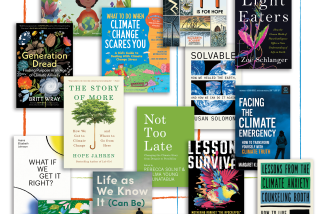Essays go in search of a strong editor
From William Wordsworth to Gary Snyder, it’s hard to think of a poet since the dawn of the Industrial Revolution who hasn’t been, to some extent at least, an environmentalist: a lover of nature and a critic of the dehumanizing aspects of modern civilization. If poetry involves vision, the picture of what has been happening to the natural world is all too clear for anyone, let alone a poet, to miss.
Among the poets sharing this concern is W.S. Merwin, who not only perceives the dangers threatening our environment but also recognizes the difficulties of keeping this vital issue on the front burner: “Part of the unease that the word [“environment”] touches off,” he notes, “is a well-learned response to the facts themselves, the news of which, in our lifetimes, has been consistently and increasingly so ominous that many avoid paying attention to them if they can.”
The problem, thus, is not that the fate of our planet is unimportant; the problem is that it is too important, perhaps too overwhelming for a public more inclined to focus on trivialities. Merwin even finds the word “environment” inadequate because it suggests our surroundings but does not really convey how deeply and inextricably we and our surroundings are entwined.
The title of this essay collection, “The Ends of the Earth,” has twofold significance. On the one hand, it refers to the far-off places that captured the attention of venturesome souls like Jean-Francois Galaup de La Perouse, head of a notably non-exploitative expedition to Hawaii and the South Pacific, and Sydney Parkinson, who accompanied Capt. Cook and feverishly painted pictures of wildlife before succumbing to malaria. But “ends” also carries a connotation of purpose: What use should our hyperactive species make of Earth and how is use to be distinguished from abuse?
Of the eight essays in this collection (all but two of them previously published in various journals), only three directly address the problems of a deteriorating environment. “The Winter Palace” and “The Winter Palace Revisited” describe two trips -- in 1994 and 2000 -- to the Mexican wintering site of the monarch butterfly.
Although some effort was made to establish sanctuaries to protect these sites from deforestation and other menaces, what Merwin found was far from encouraging. In the six years between his two visits, the situation worsened. Governmental regulations were “languidly” enforced, if enforced at all; deforestation -- illegal logging by local farmers and lumber companies -- proceeded apace; and resultant dust was everywhere, rendering the environment rebarbative to humans as well as to butterflies.
Tourists crowded the sanctuary (they were given face masks to shield them from the dust, but at the oxygen-thin high altitude, most chose to discard the masks in order to take deeper breaths). Guards who once made sure that visitors stayed on the paths had given up trying: hordes of people roamed everywhere, trampling the plants on which the butterflies were supposed to feed.
Dispiriting though they are, Merwin’s essays on the monarchs’ “Winter Palace” are exemplary pieces of writing: They offer a clear account of the life cycle and migratory patterns of the monarch, provide a vivid description of what it is like to visit the sanctuary and highlight the complicated social factors behind the continuing problems.
The same cannot be said of “Snail Song,” a short but slow-going chronicle of the human and natural history of a Hawaiian valley. Here Merwin seems to operate on what might be called a kind of autopilot environmentalism, writing out of the automatic assumption that native species are always better than imported ones, that agriculture equals exploitation, that European and American incursions into terra previously incognita are bad.
Merwin takes a broader, more tangential approach to environmental issues in two essays about 18th century European explorers of the Pacific. Discussing the paintings and drawings left by Sydney Parkinson, he first falls into the rather hackneyed routine of complaining that these images based on dead animals seem lifeless. But as he becomes more caught up in telling the sad story of this young artist-naturalist who died in his 20s, his own writing gathers liveliness and force.
French explorer La Perouse provides Merwin with even more fascinating material: an expedition conceived in the most humanitarian terms; chilling encounters with “noble savages” who turn out to be more savage than noble; a background story as engrossing as the voyage itself, featuring everything from King Louis XVI to La Perouse’s quest to marry his true love against his family’s wishes. But then, having captivated us, Merwin slides into a tedious account of the various expeditions undertaken in the two centuries after La Perouse’s disappearance to find out exactly what happened to him.
Many of these essays demonstrate an unfortunate knack for losing the thread of a story. The writing is alive one moment, the pulse fades in the next. This holds true whether Merwin is recounting his own experiences visiting the Holy Mountain of Athos or serving up a memoir of his friendship with publisher George Kirstein, the overshadowed younger brother of two more famous cultural mavens, the balletomane Lincoln and the scholar Mina.
Merwin’s fine insights into Kirstein’s personality are swamped by extraneous material, including an interminable-seeming account of a sailing trip. Here, as elsewhere, he simply doesn’t seem to know what to leave out. One can’t help wondering how the essays in “The Ends of the Earth” would have benefited from an exigent, judicious editor, who might have pared away the encumbrances that obscure so much that is valuable and interesting in them.
More to Read
Sign up for our Book Club newsletter
Get the latest news, events and more from the Los Angeles Times Book Club, and help us get L.A. reading and talking.
You may occasionally receive promotional content from the Los Angeles Times.






